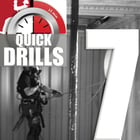Roco QUICK DRILL #6 - Splitting One Rope Between Two Systems
 At times, it may be necessary to use a single rope split between two different rescue systems. This can be useful when all ropes are being used for other purposes, such as taglines, extending anchors, etc. Being proficient in using a single rope between two systems helps spread the resources and may be more than just another tool in your toolbox. Someday, it could be crucial to a successful rescue!
At times, it may be necessary to use a single rope split between two different rescue systems. This can be useful when all ropes are being used for other purposes, such as taglines, extending anchors, etc. Being proficient in using a single rope between two systems helps spread the resources and may be more than just another tool in your toolbox. Someday, it could be crucial to a successful rescue!
Here’s the drill:
1. Choose an elevated location that is less than one half the length of the rope – plus, allow a good margin of extra rope. For example, if using a 150 ft. rope, you could use a platform that is about 40 feet high.
2. Select two appropriate anchor points near each other. One will be for the main line; the other for the safety.
3. Build a lowering system using one end of the rope and the main line anchor. Anchor the descent control device and prepare for a lower.
4. Build your safety line using the other end of the rope and the second anchor.
5. Lower the rescuer, package your patient, and recover them both.
6. Try doing this using different descent control devices and different types of systems (piggy back vs. Z-rig). Play "what if" and problem solve.
Tips/Hints:
• Pre-measure your lines. We say start where you want to end up! This drill is nothing more than lowering the end knots to the ground to assure you have enough rope to do the lower. It also allows you to inspect the rope for damage before life loading the lines.
• If you do this with both ends of your rope and you have enough rope to reach from the ground to your two anchor points independently, you now know you have enough rope for both the mainline and safety line system.
• Any additional line left between the two systems can be used to extend anchor points, rigging or build mechanical advantage systems.
• Many times we use this technique of splitting rope from a single rope bag as our safety/retrieval line for rescue entrants during confined space rescue. We use rope bags that allow us to work from either end of the rope easily. We take two different color ropes usually 125 ft., tie them together, and load the bag from both ends with the knot in the middle (double fisherman). This allows us to run safety lines to two rescuers out of one bag. Since each rope is a different color it helps with line management, communications, identification and emergency retrieval. If your rescue scenarios require entrants to advance more than 125 ft., then longer ropes can be substituted. The rope can also be used as a single 250 ft. safety line provided you have knot passing capabilities.
• Manage your ropes! Without good rope management, your work area can easily turn into a tangled mess.
This drill forces rescuers to think ahead and “outside the box” in order to allocate appropriate lengths of rope for each system or how to better use limited equipment resources. It is an excellent exercise in efficiency, rope management, and housekeeping – while demonstrating the importance of each when managing this type of system.
Next in this series: QUICK DRILL #7 - Anchor Selection and Rigging





